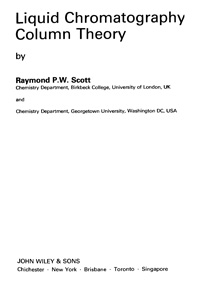Liqid Chromatography Column Theory
| Автор(ы): | Scott R. P. W.
06.10.2007
|
| Год изд.: | 1992 |
| Описание: | Liquid Chromatography Column Theory Raymond P.W. Scott, Chemistry Department, Birkbeck College, University of London, UK and Chemistry Department, Georgetown University, Washington DC, USA Analytical techniques based on separation processes, such as chromatography and electrophoresis, are finding a growing range of applications in chemical, biochemical and clinical laboratories. The aim of the series is to provide the analyst in these laboratories with well-focused books covering individual techniques and important aspects of the techniques, so that they can be applied more efficiently and effectively to contemporary analytical problems. This book is designed to cover the important subject of liquid chromatography column theory. It provides a lucid account of the principles involved in the separation process which will allow the analyst to understand the function of the column, how to design the optimum column for a specific application and how to use it in the most efficient manner. This reference work will be of value to a broad spectrum of scientists since chromatography is now one of the more popular methods of analysis and is used in such diverse fields as biotechnology, environmental science, forensic science and in pharmaceutical product control. |
| Оглавление: |
 Обложка книги.
Обложка книги.
The Factors that Control Retention and Selectivity [4] Ionic Interactions [4] Polar Interactions [5] Dispersive Interactions [5] The Physical Nature of the Column [6] The Column Environment [8] Chromatography Nomenclature [9] LC Column Theories [12] References [13] 2 The Plate Theory [15] The Solution of the Differential Equation [19] The Retention Volume of a Solute [22] TheCapacity Ratio of a Solute [25] The Separation Ratio [26] References [26] 3 The LC Column Dead Volume [27] References [38] 4 Extensions of the Plate Theory [39] The Elution Curve of a Finite Charge [39] Peak Asymmetry [41] Column Efficiency [45] The Position of the Points of Inflection [48] The Gaussian Form of the Elution Equation [50] References [52] 5 Applications of the Plate Theory [53] The Maximum Sample Volume [53] Vacancy Chromatography [55] The Resolving Power of an LC Column [60] The Effective Plate Number [63] The Peak Capacity of a Chromatographic Column [67] Precision as an Alternative to Resolution [74] A Theoretical Treatment of the Heat of Adsorption Detector [77] References [90] 6 Introduction to the Rate Theory [93] The Summation of Variances [94] Extra Column Dispersion [95] The Alternative Axis of a Chromatogram [96] The Random Walk Model [98] Dispersion Processes that take Place in an LC Column [102] The Multipath Process [102] Longitudinal Diffusion [103] The Resistance to Mass Transfer in the Mobile Phase [105] The Resistance to Mass Transfer in the Stationary Phase [106] References [106] 7 The Van Deemter Equation [109] References [121] 8 Alternative Equations for Peak Dispersion [123] The Giddings Equation [123] The Huber Equation [124] The Knox Equation [126] The Horvath and Lin Equation [128] The Golay Equation [128] References [133] 9 Experimental Validation of the Van Deemter Equation [135] The Effect of the Function of k' on Peak Dispersion [149] References [152] 10 Extra Column Dispersion [153] The Effect of Sample Volume [153] The Sample Valve [154] Connecting Tubes [154] Low Dispersion Connecting Tubes [158] Serpentine Tubes [161] Column Frits [164] Dispersion in the Detecting Cell [164] Effect of Extra Column Dispersion on Column Radius [167] Mass Sensitivity [172] References [173] 11 LC Column Design-The Design Protocol [175] Performance Criteria [176] The Reduced Chromatogram [177] Instrument Constraints [179] Elective Variables [181] Column Specifications and Operating Conditions [182] Analytical Specifications [183] 12 LC Column Design - The Design Process for Packed Columns [185] The Optimum Particle Diameter [188] The Optimum Column Length [192] The Minimum Analysis Time [194] The Optimum Column Radius [196] The Optimum Flow Rate [199] The Minimum Solvent Consumption [201] The Peak Capacity of the Optimized Column [202] Maximum Sample Volume [204] The Optimum Capacity Ratio [204] Packed Column Design Equations [206] Computer Program for Packed Column Design [208] Gradient Elution [212] References [213] 13 LC Column Design - The Design Process for Open Tubular Columns [215] The Optimum Column Radius [218] TheTQptimum Length of an Open Tubular Column [221] Minimum Analysis Time [222] The Optimum Flow-Rate [224] Maximum Sample Volume and Maximum Extra Column Dispersion [226] The Maximum Permissible Detector Dispersion [230] Design Equations [231] The Open Tubular Column in LC [233] References [234] 14 Preparative Liquid Chromatography Columns [237] Preparative Column Design [238] The Efficiency Required from the Preparative Column [238] Optimum Particle Diameter [239] The Column Length and Analysis Time [241] The Column Radius [244] The Optimum Flow-Rate [247] Solvent Consumption [248] Column Wall Thickness [248] Preparative Column Design Equations [250] The Use of the Design Equations [251] Computer Program for Preparative Column Design [252] Discussion [253] Column Overload as an Alternative to Column Design [259] Sample Volume Overload [259] Sample Mass Overload [261] References [263] List of Symbols [265] Appendix 1 The Diffusion Coefficients of some Low Molecular Weight Substances [268] Appendix 2 The Diffusion Coefficients of some Peptides [270] Appendix 3 The Physical Properties of some Solvents Employed as Mobile Phases in LC [271] Index [273] |
| Формат: | djvu |
| Размер: | 1717481 байт |
| Язык: | ENG |
| Рейтинг: |
334
|
| Открыть: | Ссылка (RU) |